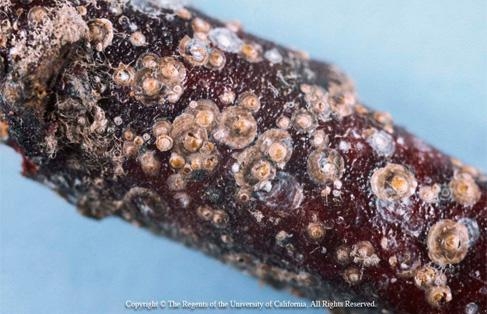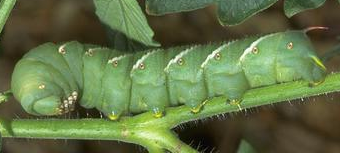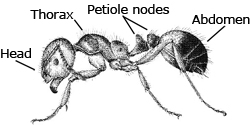By Brent McGhie, Butte County Master Gardener, July 26, 2013
The University of California recommends the use of Integrated Pest Management (IPM) to control garden pests. The goal of IPM is to use the least harmful control method(s) that will be effective in managing a particular pest. Depending on the pest, these methods include one or more of the following: cultural controls, biological controls, mechanical and physical controls and chemical controls (pesticides). When using IPM, it is recommended that gardeners resort to the use of pesticides only as a last resort, after other control methods have been tried and found wanting.
Before using a pesticide, be certain a pest is the actual cause of the problem you are experiencing. For example, plants can be damaged by incorrect watering, poor drainage, accidental herbicide exposure, or physical damage from wind, hail, sun scorching and other weather-related factors. A decision should also be made on how much damage you are willing to tolerate. Minor surface blemishes on fruit caused by thrips are probably an acceptable alternative to pesticide use. Once it has been determined a pest is present and is causing a major problem, identify the pest and research alternative control methods. If you need help, your Butte County Master Gardeners can provide guidance in these areas. In most cases, even if a pesticide is utilized, a combination of measures will provide the best long-term control.
Once the decision to use a pesticide has been made, the next step is to choose the right pesticide. The University of California Pest Notes series is a good source of information for identifying the least toxic pesticides appropriate for a specific pest. Low toxicity pesticides include insecticidal oils and soaps as well as the microbial insecticide, Bacillus thuringiensis, which is effective against many caterpillars, but nontoxic to other animal life. Pest Notes are available from your local Master Gardener program (based at the UC Cooperative Extension Office) and online at the UC Statewide IPM Program website (http://www.ipm.ucdavis.edu/index.html)
Before purchasing a pesticide read the label to be certain the plant you plan to use it on is listed on the label. Never use pesticides designated for use on ornamental plants on plants that will be eaten unless they are also listed on the label. Also, be aware that most pesticides only control certain stages of a pest’s life cycle. For disease control it is important to remember that fungicides are preventive and, although they may slow the progress of an existing infection, they will not eliminate it. Herbicides may be pre-emergent (preventing weeds from germinating successfully), or post-emergent (designed to kill actively growing weeds). Herbicides may also be broad-spectrum (killing weeds of almost any type), or selective in the type of weeds they affect.
Whenever a pesticide is used, all instructions should be read and carefully followed. Especially critical are instructions concerning proper application and safety precautions (for example, the use of protective clothing and eyewear).
To minimize pesticide contamination of the environment, mix only what is needed for immediate use and never use more than what the directions recommend. To further limit environmental exposure, avoid widespread applications; instead, apply only to affected areas. Do not spray during windy conditions when pesticides can be blown away from their intended target. To prevent contamination of waterways, avoid spraying near storm drains, creeks, or other bodies of water. It’s important that the application dry on the target before it gets wetted by rain or irrigation. Unless otherwise specified, do not spray just before irrigating, or before rainy weather. Additionally, be aware that spraying pesticides on hard surfaces such as foundations, driveways or sidewalks increases the likelihood that they will be washed off into storm drains.
The only legal way to dispose of pesticides is to take them to a local hazardous waste disposal facility. Do not pour unused or excess material down the drain, onto the soil, into waterways, into gutters, or into the trash. However, in California it is legal for homeowners to dispose of empty pesticide containers in the trash. Before disposing, containers should be triple rinsed and the rinse water used as part of the last application. To find the location of the closest hazardous waste disposal site, call the California Environmental Hotline (1-800-253-2687), or visit the “Earth911” website.
Information in this article is based on “Pesticides: Safe and Effective Use in the Home and Landscape” at UC IPM Online (Pest Note #74126).
By Michelle Ramsey, Butte County Master Gardener, June 28, 2013
If something is eating your tomato plants or your eggplants, hornworms may very well be the culprit.
Two common species of hornworms seen in the garden are the Tomato Hornworm (Manduca quinquemaculata) and the Tobacco Hornworm (Manduca sexta). They can be differentiated by how many white stripes the larvae have on each side of their bodies. Tobacco hornworm larvae have 7 diagonal stripes on each side, while the tomato hornworm larvae have 8 chevron-shaped stripes. Mature hornworm larvae can be very large, up to 4 inches long (they will most likely be the largest “caterpillar” you’ll see in your garden). Hornworms feed on blossoms, leaves and fruit and are particularly known to cause damage to tomatoes and eggplants. Damage to plants typically occurs in mid-summer (but may also be seen in late summer). In their larval stage, hornworms are green caterpillars often seen hanging upside down on the plants. They have a “horn” at the rear end of their body. In the early summer, hornworm eggs (laid singly on leaves), hatch into larva. The larvae feed on leaves for 3-4 weeks and then burrow into the ground to pupate. The pupa over-winter in the ground and then emerge as adult moths. Adult hornworm moths are strong fliers with a wingspan of up to 5 inches.
The larval form of the hornworm is the only stage that causes damage to your plants. Hornworms can be hard to find as their green coloring provides a nice camouflage for them amidst the tomato plant leaves. Foliage damage (and possibly some damage or scarring of fruit) and large droppings on the dirt under the plants are indications that hornworms are present in the garden. When the plant is shaken gently hornworms will sometimes make a clicking sound which can help you locate the intruder. Natural enemies of hornworms are the Trichogramma parasitic wasp which lays eggs in the hornworm eggs and the Hyposoter exiguae parasitic wasp which infests the hornworm larvae as a parasite.
The most common methods of hornworm management are hand-picking them off plants and/or snipping them with shears. However, if the hornworm infestation is out of control, an organic spray (Bacillus thuringiensis or Spinosad) may be applied. These sprays are effective against smaller hornworm larvae but will not destroy the natural enemies of the hornworms. Crop rotation and disking (breaking up and turning over the soil) after harvest destroys pupae in the soil, and will help prevent emergence and a repeat of the hornworm life cycle in your garden the following year.
For additional information visit:
http://www.ipm.ucdavis.edu/PMG/r783301111.html
By Michelle Ramsey, Butte County Master Gardener, June 14, 2013
We often experience ants in our homes when weather conditions change. They are typically looking for food, water, warmth, and/or protection from extreme weather conditions. Ants belong to the insect order Hymenoptera and are close relatives of bees and wasps. The most common outdoor ant found in California is the Argentine worker ant. The Argentine worker ant is approximately 3mm long, dark colored and does not sting. They have no natural enemies. Their colonies have multiple queens and only the queens lay eggs. An ant’s life cycle moves from egg to larva to pupa to adult. Their nests are normally found in moist soils, under debris or along sidewalks and driveways. Argentine ants are drawn to sweet foods but will also feed on protein (e.g. dead bugs). The Argentine ant will venture up to 100 feet away from the nest to find food, water and shelter inside buildings. Once inside, if ants find food, they will continue to invade until the food source is removed and/or the entryway sealed.
While it is not realistic to eradicate all ants from your backyard, you can effectively reduce the number of ants entering your home by following a 3-Step integrated approach as follows:
Minor Indoor Problem (small trail of ants observed infrequently). Prevent further intrusion by:
1) Identifying the location where the ants are getting into the house. Inspect baseboards, floors, electrical outlets, vents, pipes, drains and walls for any entryways and seal them off (caulk is good for this). Destroy any nesting sites found close to the house. Cut back trees, shrubs or wooded material touching the house and clear away mulch or debris that is next to the house.
2) Clean up food and water sources in the home. All sources of “attractive” food should be removed or securely sealed. Use soapy water to kill ants and eliminate their trails.
Moderate (trails of hundreds of ants) and severe (several hundred to thousands of ants continue to invade for weeks or months). Supplement steps 1 and 2 above with the addition of bait stations as follows:
3) Install bait dispensers around the outside of the house (UC Researchers have had success using bait dispensers such as KM AntPro Liquid Bait Dispenser). Baits are more effective and less toxic than traditional pesticide treatments for ants. Baits are insecticides mixed with materials that attract worker ants. The advantage of a bait station over an insecticide spray is that the spray only kills the worker ant while the bait station allows worker ants to take the bait back to the colony to feed and kill the colony ants, including the queen ant. When all the queens die, the colony is destroyed. Continue to refill dispensers regularly with liquid borate-based bait until the ant problem ceases. It is critical that you select the right bait/attractant for Argentine ants (liquid baits with 1% or less borate are suggested). Install at least one dispenser on each side of the house, next to structures where ants are trailing (but at least 5 ft. from any nest). Keep ant bait stations out of direct sunlight.
Following the 3-step approach above should correct home ant invasions.
For more information visit:
http://www.ipm.ucdavis.edu/PMG/PESTNOTES/pn7411.html
By Jeanette Alosi, Butte County Master Gardener. March 15, 2013

Scales are insects that suck plant fluids by inserting a tiny straw-like mouthpart into various parts of a plant. Scales are very small, and when they are doing their damage (in the larval stage) they are wingless and have no distinguishable body parts. Unlike aphids, for example, scales are slow moving or immobile.
The damage of a scale infestation depends upon the type of scale, the species of plant, environmental factors, and the proximity and numbers of natural enemies.
The two common scale families are soft and armored scales. Soft scales may be smooth, cottony, or waxy. They are usually about one-eighth to one-quarter-inch in diameter, and round to oval in shape. They feed on fluid-conducting phloem plant tissue and excrete honeydew. Common soft scales are black scale, brown soft scale, cottony cushion scale, and European fruit lecanium scale.
Armored scales are tinier than soft scales (less than one-eighth-inch) with a flattened, removable scale cover. They do not excrete honeydew. Common armored scales include California red scale (on citrus) and San Jose scale.
There are many other species of scales and scale look-alikes. It is important to identify the scale family in order to determine the most effective control methods.
Most female scales produce eggs without mating. The eggs hatch into crawlers (also known as first instar nymphs). Crawlers, about the size of a typed period, are usually pale yellow to orange. After a few days, they establish themselves on a nearby feeding site and rarely move again. Once they become firmly attached to a feeding site, scales will grow through several larval stages during their lifetime (although their appearance will not radically change) before becoming adults. Most soft scales produce one generation a year. Armored scales produce several generations a year.
Scale damage is dependent upon the level of infestation. In addition to yellowing leaves, plants affected by scales may experience premature leaf drop and discolored blemishes on fruit, leaves or twigs. If heavily infested with armored scales, twig dieback may also occur. The main problem with soft scales is the secretion of sugary honeydew which attracts ants and encourages the growth of black sooty mold. Soft scales rarely kill trees and shrubs but can reduce plant vigor, while recurrent infestations of armored scales can cause twig and branch dieback.
In most cases, scales are controlled by natural enemies, especially parasitic wasps. A parasitized scale will appear darker than normal. Other natural enemies include lady beetles (“lady bugs”), lacewings and mites. Because ants feed on the honeydew secreted by scales, they will protect the scales from their natural enemies. Controlling ants will therefore help to decrease the scale population. Beware of using broad-based insecticides because they kill beneficial insects and scale parasites indiscriminately, as well as the scales and ants.
Cultural practices to control scales include pruning to improve air movement and light penetration into dense canopies, and selection of plants that are less prone to scale infestation. Because scales tend to be host-specific, replace problem plants with plants less attractive to scales. Planting flowering plants near scale infestations will aid in attracting natural enemies.
For limited scale infestations, prune out heavily infested branches. Pruning to open up the tree canopy will expose scales to the hot sun, increasing their mortality.
Heavy infestations may require the use of horticultural oil during the dormant season or when the crawlers (nymphs) are active during the growing season (late winter to early summer). Read the label carefully when mixing with water, as horticultural oils may damage plants under certain conditions. To smother (and destroy) the scales, affected areas including the undersides of leaves must be thoroughly coated with the horticultural oil spray. On larger ornamental shade trees (non-fruit-bearing), a soil-applied systemic insecticide might be considered.
For more information, see “Scales, Pest Notes Publication 7408,” at
http://www.ipm.ucdavis.edu/PMG/PESTNOTES/pn7408.html
Photo: San Jose scale on peach branch




